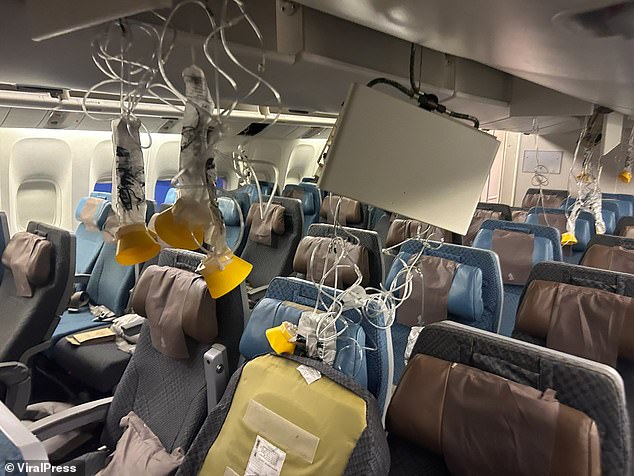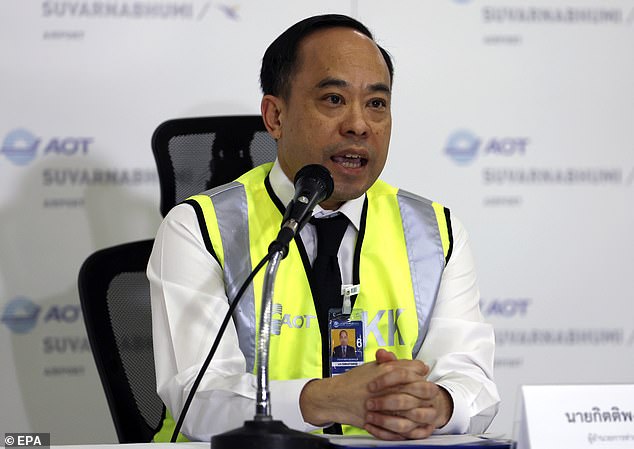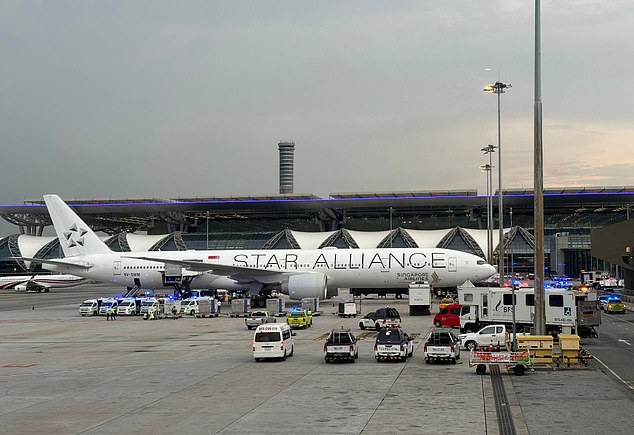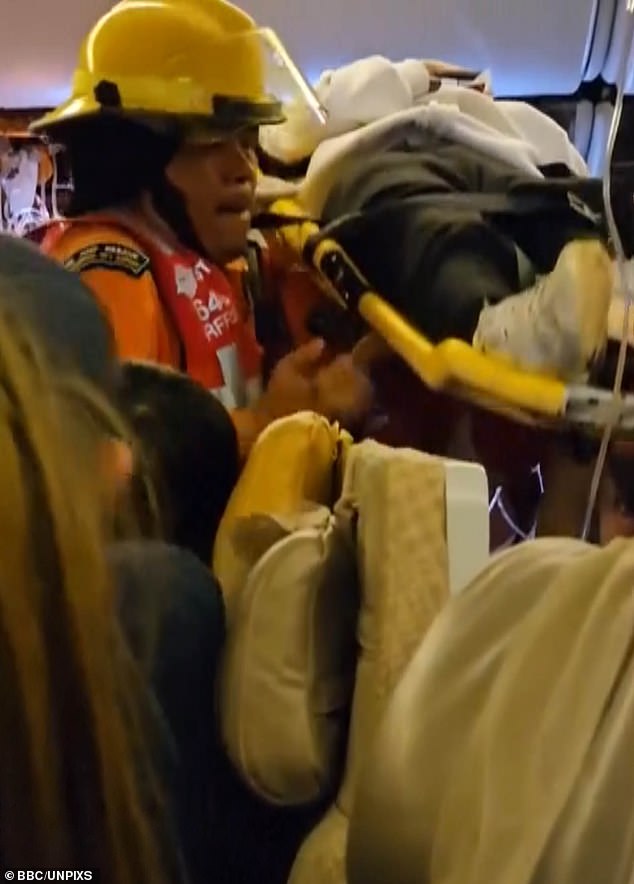JULIAN BRAY: Why turbulence is worse than ever and increasing
Almost all of us have experienced turbulence on an airplane at some point in our lives, even if it was no more disturbing than a strange shudder. Sometimes, in the case of Singapore Airlines flight SQ321, it can be devastating for those on board.
“Turbulence” does not refer to drinks spilled in the cabin, or tray tables falling out of stock. Rather, it refers to the chaotic movement of air outside the craft.
But what causes it and how dangerous can it be? Like water in the ocean, the air in the sky is always moving, and not always predictable.
After about 11 hours of flying time from London, the plane descended sharply 6,000 feet in just five minutes, causing chaos in the cabin. In photos of the aftermath, a flight attendant was seen with blood running down her face (pictured)

Passengers are seen in the cabin after the incident, with belongings scattered on the floor and oxygen masks dangling from above
What we understand as turbulence is usually caused by what the industry calls ‘wind shear’: changes in the direction and/or speed of the wind. When this happens, the force of the wind causes an aircraft to shake and shudder.
Because wind shear typically occurs at 20,000 feet to 50,000 feet, they pose a common hazard to commercial aircraft, flying between 33,000 feet and 42,000 feet.
There are three things that most often cause these troublesome gusts: extreme weather, such as thunder; mountainous environments that hurl air waves high into the sky; and jet streams, which are essentially high-speed streams of hot air.
Yesterday’s Singapore Airlines incident was not the result of a particular storm, nor did flight SQ321 fly over the mountains.

Video shows emergency services removing a passenger from the cabin on a stretcher

Oxygen masks hang from the ceiling in the cabin of a Singapore Airlines flight
Therefore, it is likely to be categorized as an example of clear air turbulence (CAT), the type that occurs at high altitudes where conditions are clear and therefore most dangerous, as the phenomenon is invisible to pilots.
Fortunately, airplanes nowadays are equipped with a high-tech gadget called an ‘infrared Doppler radar’. This ingenious invention allows pilots to view highly advanced 3D images of the approaching airspace, including wind direction and speed.
Pilots can therefore respond in real time and navigate around the detected turbulence. In the US alone, airlines spend around $100 million (£78 million) a year on avoiding turbulence.
But such equipment is not infallible. Wind shears can occur virtually without warning, rendering radar systems useless.
According to the U.S. National Transportation Safety Body, about 28 percent of turbulence events occurred without any warning between 2009 and 2018. It is likely that this happened in the case of flight SQ321.
If the pilot and co-pilot had seen such a rough air pattern on radar, they would certainly have navigated around it.

Suvarnabhumi Airport General Manager Kittipong Kittikachorn addresses the media during a press conference after the London to Singapore flight was diverted

Singapore Airlines plane and ambulances are seen on the tarmac at Bangkok’s Suvarnabhumi International Airport
Given the sophistication of today’s turbulence detection technology, you would expect incidents like yesterday’s to decrease. Instead, we are witnessing a dramatic increase in turbulence in the air.
Research published last year by meteorologists at the University of Reading found that our skies are about 55 percent more turbulent than they were 40 years ago. Scientists found that at a typical spot in the North Atlantic Ocean – one of the busiest routes in the world – the total annual duration of clear-sky turbulence increased from 17.7 hours in 1979 to 27.4 hours in 2020. The moderate turbulence in the same region it is also by as much as 37 percent.
Paul Williams, co-author of the study, expects clear-air turbulence over the North Atlantic to increase by 181 percent by 2050-2080 as rising global temperatures increase the speed and unpredictability of wind shear.

Passengers said Thai emergency services worked quickly to help the occupants after the plane made an emergency landing
Other routes that remain more susceptible to turbulence include the air above mountain ranges. When fast-traveling air encounters mountains, it shoots upward, creating air waves that are not unlike waves in the ocean.
So-called ‘mountain waves’ can also form against large buildings such as skyscrapers. Planes landing or taking off from London City Airport encounter problems with mountain waves due to their proximity to the capital’s towering skyline.
Rising temperatures – and rising skylines – mean increasing turbulence is inevitable. Today, only one in 50,000 flights experiences so-called severe turbulence. That won’t be the case for much longer. So what can you do to reduce the chance of turbulence during a flight?
It is often said that you should sit in the middle of a plane to avoid the worst discomfort, because the center of the plane moves the least when it experiences turbulence. This is theoretically correct, but the difference is actually negligible.
If you sit over the wing during heavy turbulence, you may notice it flexing. This is completely normal. In fact, the carbon fiber structure is designed to absorb and distribute the intense stress of high-speed wind shear. Simply put, if the wings didn’t bend, they would break.
In general, night is the safest time to fly. As any meteorologist will tell you, sudden changes in air temperature are much less common once the sun has set.
If you are unlucky enough to encounter serious turbulence, it is essential that you take a few simple steps to protect yourself. As tempting as it may be to get up and comfort your loved ones, you should sit down and fasten your seat belt securely around your hips. and waist. Pull the strap too low, below your hips, and you risk being propelled up and out of the straps.
Andrew Davies, a father-of-two from Lewisham, south-east London, was one of the passengers on flight SQ321.
He learned a very sensible lesson from the traumatic experience: “Always wear a seat belt,” he told the Mail. “Everyone who was injured was not wearing a seatbelt. The people they stopped, including myself, are not – as far as I could see.”
If the overhead lockers burst open and debris starts flying through the cabin, assume the brace position: head between legs, hands on head.
A majority of serious injuries that occur during turbulence are from lacerations to the head from flying objects.
I’ll never forget traveling between London and Canada on a small airline called Peach Airlines in 2016. I stood at the bar cart and enjoyed a drink as we sailed across the North Atlantic.
Suddenly the plane dropped in height like a stone. My drink shot out of my glass and then fell back into the cup.
It seemed funny at the time, but it also felt like a reminder from Mother Nature of who was really in charge up there.
Julian Bray is a major incident expert and former advisor to Alitalia
